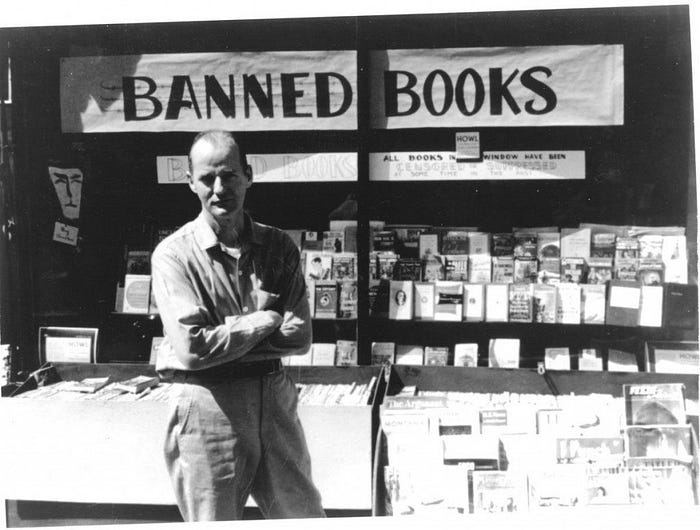The San Francisco Beat Writers

While it is said that Jack Kerouac, Allen Ginsberg, William S. Burroughs and Neal Cassady are the original Beat writers, there are a number of other key figures that would cause the movement to explode across the nation.
Kerouac and the Beats spent a lot of their time bouncing around the States, between New York and San Francisco. While on the west coast, they met a few other poets who were making waves and bonds were quickly formed.
[This post has affiliate links, which means I may receive commissions if you purchase through links I provide.]
Kenneth Rexroth
Kenneth Rexroth was born Dec. 22, 1905, in South Bend, Indiana to Kenneth Charles Marion Rexroth and Delia Reed.
A talented poet, essayist and social critic, Rexroth was one of the first American poets to explore traditional Japanese styles such as haiku. His poetry, which touched on radical politics, love, erotica and nature, first started being published in magazines in the 20s. When he read, it was alongside live jazz music.
Rexroth met Allen Ginsberg through William Carlos Williams in the early 50s. He then introduced Ginsberg to Gary Snyder and the three men would soon become famous in San Francisco’s underground poetry scene.
Acting as master of ceremonies, Rexroth put together the poetry reading at the Six Gallery on Oct. 7, 1955. Ginsberg and Snyder would read, along with Philip Lamentia, Michael McClure and Philip Whalen.
Although Time Magazine later referred to Rexroth as “father of the Beats,” Rexroth himself has said he was not a beat poet. He would later become critical of the beat movement. But, he did play a significant role in the generation and is also regarded as a chief figure in the San Francisco Renaissance.
He died June 6, 1982, at the age of 76 in Santa Barbara.
His works include The Phoenix and the Tortoise, Beyond the Mountains, Flower Wreath Hill: Later Poems, and With Eye and Ear.
Lawrence Ferlinghetti
Lawrence Ferlinghetti was born March 24, 1919, in Yonkers, New York to Clemence Albertine Mendes-Monsanto and Carlo Ferlinghetti.
In 1953, Ferlinghetti and Peter D. Martin founded City Lights Bookstore in San Francisco. In 1955, Ferlinghetti launched City Lights Publishers with the Pocket Poets Series, which consisted of his own first book of poems, Pictures of the Gone World.
The fourth number in the series would be Ginsberg’s Howl, which was seized by San Francisco police in 1956 and resulted in Ferlinghetti and Ginsberg being tried on obscenity charges. In the end, Judge Clayton Horn found Howl not obscene and the book was released to the public, but the attention drawn from the trial had already made Ginsberg, City Lights Books, the San Francisco Renaissance and Beat writers national literary figures.
The Pocket Poets Series also published books by Kenneth Rexroth, Denise Levertov, Robert Duncan, William Carlos Williams, and Gregory Corso. Under City Lights Publishers, Ferlinghetti published works by many of the Beats, including Jack Kerouac, William S. Burroughs, Michael McClure, Diane DiPrima and Gary Snyder.
When the Beat writers were in San Francisco, they made City Lights Bookstore their headquarters. Ferlinghetti also owned a cabin in Big Sur, which became the focal point of Kerouac’s novel Big Sur.
Lawrence Ferlinghetti is still running City Lights Booksellers & Publishers. He remains a talented poet, painter, liberal activist, and art critic.
His own publishings include Pictures of the Gone World, A Coney Island of the Mind, Starting from San Francisco, The Secret Meaning of Things and Back Roads To Far Places.
Michael McClure
Michael McClure was born Oct. 20, 1932, in Marysville, Kansas and grew up in Seattle. As a boy, he was fascinated with nature and wildlife and had hopes of becoming a natural scientist. Instead, he moved to San Francisco as a young man and participated in a poetry workshop with Robert Duncan. He was soon involved with the Beat movement and San Francisco Renaissance.
At a party following a W. H. Auden reading, McClure met Allen Ginsberg and the two men shared their dreams and visions of William Blake. They began meeting regularly in North Beach to discuss poetry and the scene.
At the age of 22, McClure became one of the five poets to read at the Six Gallery poetry reading. It was here that he first met Jack Kerouac. Kerouac was in the audience and while Ginsberg read Howl for the first time, he shouted “Go” and passed gallon jugs of red wine around the room.
This scene is described in Kerouac’s The Dharma Bums, in which McClure’s character is “Ike O’Shay.” He was immortalized as “Pat McLear” in Kerouac’s novel Big Sur.
McClure is an American poet, playwright, songwriter, and novelist.
His works include Passages, Jaguar Skies, Dark Brown, Huge Dreams, Rebel Lions, Rain Mirror, Plum Stones, The Mad Cub and Adept.
